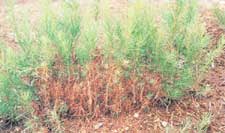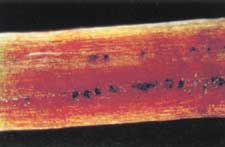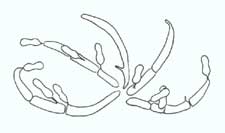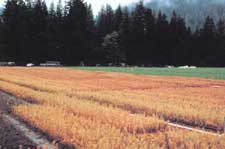Larch Needle CastSally J. Campbell - Plant Pathologist, Region 6, USDA Forest Service, Portland, OR. Cordell C.E., Anderson R.L., Hoffard W.H., Landis T.D., Smith R.S. Jr., Toko H.V., 1989. Forest Nursery Pests. USDA Forest Service, Agriculture Handbook No. 680, 184 pp. Hosts Larch needle cast, caused by the fungus Meria Iaricis, affects many larch species, including western, European, Japanese, hybrid, and Siberian larches. Distribution The disease is widespread in North American forests. It is common on nursery stock in the Northwestern United States and western Canada. Damage Severe infection by M. laricis, where virtually every needle is killed, will result in seedling mortality. If infection is relatively light, most seedlings will survive; seedling growth will be reduced, however, and many seedlings may need to be culled. In the Northwest, good field survival of seedlings moderately to severely infected in the nursery has been obtained.
In Idaho and British Columbia, the disease has also been observed in containerized nursery stock. The symptoms appear from mid- to late summer. Biology The fungus overwinters, presumably as spores or mycelium, on fallen needles or on needles retained by trees or seedlings. Initial infection may occur as soon as buds break and needles have expanded in the early spring. On 1-0 seedlings, infection most likely originates from spores produced on adjacent 2-0 seedlings or on infected larch in the vicinity of the nursery. Infection on 2-0 seedlings originates from infected needles shed the previous winter. Fruiting bodies and conidia of the fungus are produced after infection; the process of infection and production of conidia continues throughout the spring and summer, provided weather conditions are favorable. To develop, the fungus needs high humidity and cool to moderate temperatures. Further infections are halted by hot, dry weather. Infection can also occur in the winter, but development of symptoms is slow. Control Prevention - To avoid introducing the fungus into disease-free nurseries, grow all larch from seed rather than importing stock from other nurseries. Rotate larch seedbeds so that seedlings are not grown in the same sections for consecutive years and 1-0 seedlings are not grown adjacent to 2-0 seedlings or transplants. To reduce inoculum, remove larch trees adjacent to nurseries; replace larch with other species. Transplant 1-year-old seedlings to a different part of the nursery to avoid reinfecting the seedlings with the fungus that has overwintered in fallen needles. Cultural - Since most infection occurs on 1-year old or older seedlings, outplant 1-year-old seedlings whenever possible. To have seedlings ready to outplant in 1 year, grow them at lower densities, sow in the fall, or grow in bedhouses (bare-root) or greenhouses (container). Chemical - Fungicides have not provided consistent protection- probably because it is difficult to cover all the surface of the needles. Benomyl, chlorothalonil, maneb, and sulfur (both colloidal or wettable formulations) have all shown variable effectiveness. Apply these protective fungicides at bud swell, a second time 4 weeks later, and subsequently at 2-to 3-week intervals throughout most of the growing season. Additional applications may be needed during extended periods of rain or irrigation. Continue treatments until overhead irrigation is no longer needed and hot, dry weather predominates. Fungicides are usually not needed on 1-0 seedlings unless they are scheduled for 2-0 seedlings. Selected References Hubert, E.F. 1954. Needle cast diseases of western larch. Bull. 215. Moscow, ID: University of Idaho Agricultural Experiment Station and Cooperative Extension Service. 6 P. Peace. T. 1962. Pathology of trees and shrubs. Oxford, England: Clarendon Press. 753 p. Peace, T.; Holmes, C. 1933. Meria Iarcis, the leaf cast disease of larch. Oxford, England: Clarendon Press. 29 p. |
Forest Pests: Insects, Diseases & Other Damage Agents |

|
|





